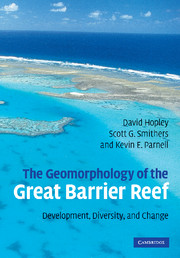Book contents
- Frontmatter
- Contents
- Preface
- Acknowledgements
- 1 Geomorphology and the Great Barrier Reef
- 2 Foundations of the Great Barrier Reef
- 3 Sea level: a primary control of long-term reef growth and geomorphological development
- 4 Oceanography, hydrodynamics, climate, and water quality as influences on reef geomorphological processes
- 5 Spatial analysis of the morphology of the reefs and islands of the Great Barrier Reef
- 6 The non-reefal areas of the continental shelf
- 7 Fringing and nearshore coral reefs
- 8 The mid-shelf reefs of the Great Barrier Reef
- 9 The coral reefs of the outer shelf of the Great Barrier Reef
- 10 Islands of the Great Barrier Reef
- 11 The accumulation of the Holocene veneer to the Great Barrier Reef
- 12 The Holocene evolution of the Great Barrier Reef province
- 13 Geomorphology's contribution to the understanding and resolution of environmental problems of the Great Barrier Reef
- References
- Geographic index
- Subject index
1 - Geomorphology and the Great Barrier Reef
Published online by Cambridge University Press: 22 August 2009
- Frontmatter
- Contents
- Preface
- Acknowledgements
- 1 Geomorphology and the Great Barrier Reef
- 2 Foundations of the Great Barrier Reef
- 3 Sea level: a primary control of long-term reef growth and geomorphological development
- 4 Oceanography, hydrodynamics, climate, and water quality as influences on reef geomorphological processes
- 5 Spatial analysis of the morphology of the reefs and islands of the Great Barrier Reef
- 6 The non-reefal areas of the continental shelf
- 7 Fringing and nearshore coral reefs
- 8 The mid-shelf reefs of the Great Barrier Reef
- 9 The coral reefs of the outer shelf of the Great Barrier Reef
- 10 Islands of the Great Barrier Reef
- 11 The accumulation of the Holocene veneer to the Great Barrier Reef
- 12 The Holocene evolution of the Great Barrier Reef province
- 13 Geomorphology's contribution to the understanding and resolution of environmental problems of the Great Barrier Reef
- References
- Geographic index
- Subject index
Summary
Introduction
The Great Barrier Reef (GBR) is the largest coral reef system in the world. It extends from 24° 30′ S in the south to 9° 30′ S in the north, a distance of about 2300 km along the north-east shelf of Australia (Fig. 1.1). Accurate estimates of dimensions and other geographical data are available only for the Great Barrier Reef Marine Park (345 500 km2) or the Great Barrier Reef World Heritage Area (348 000 km2) which also includes islands excluded from the Park. Within this area are 2900 reefs occupying over 20 000 km2 or 9% of the 224 000 km2 shelf area (Hopley et al., 1989). However, this administrative area does not include the contiguous shelf of Torres Strait, data for which are more scant. The Strait is 150 km wide and east of the line of high islands, which link Australia to Papua New Guinea, the shelf has a width of over 200 km. Estimated total shelf area here is about 37 000 km2 and, relying on comparative data from the adjacent Great Barrier Reef Marine Park (which ends at 10° 42′ S) there may be a further 750 reefs and shoals with a total area of about 6000 km2.
The GBR is also one of the best studied in the world. Although first described during James Cook's voyage of exploration in 1770, because of science's preoccupation with atolls, it did not become a major focus until after the establishment of the Great Barrier Reef Committee in 1922 and the ground-breaking year-long Royal Society Expedition to Low Isles near Cairns in 1928–29 (see below and Bowen and Bowen, 2002).
- Type
- Chapter
- Information
- The Geomorphology of the Great Barrier ReefDevelopment, Diversity and Change, pp. 1 - 17Publisher: Cambridge University PressPrint publication year: 2007
- 3
- Cited by



